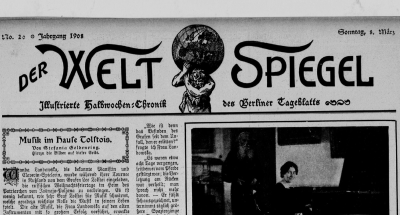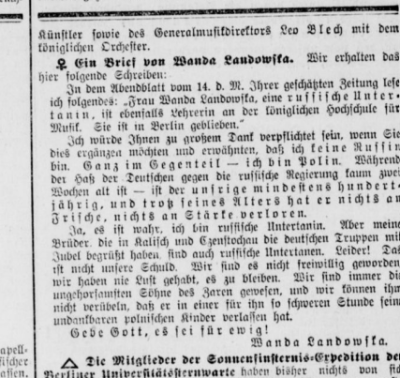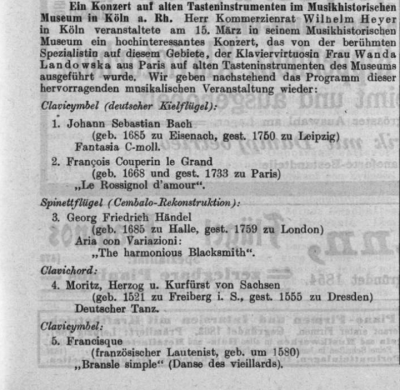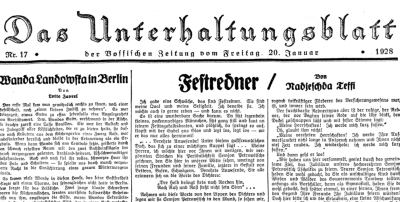Wanda Landowska

That said, it needed another two recitals before Landowska was able to realise her “ambitious, mushrooming, constant dream” of making audible the sound of early baroque instruments (until then they had only been kept in museums) on a newly made harpsichord, and was able to experience the triumphant success of her long-standing “campaign… to create an instrument that was as similar as possible to that played by Bach”[2]. In September 1911, at the so-called Kleines Bachfest in Eisenach organised by the New Bach Society, a number of works were played consecutively on the modern grand piano and a harpsichord in order to be able to compare the two. The Zeitschrift der Internationalen Musikgesellschaft reported: “To confirm the true result of this competition: the harpsichord was the instrument that enjoyed … a supreme success… However, in the interest of modern pianos, it would have been valuable to have been able to compare somewhat more spirited representatives of this instrument with the brilliant representative of the harpsichord, Frau Wanda Landowska.”
It was not until the VI. Deutsches Bachfest (presented by the Neuen Bachgesellschaft between the 15th and 17th June 1912 in Breslau) that Landowska was able to publicly present and play the “Grand Modèle de Concert” harpsichord she had herself conceived, and that had been constructed by the Pleyel company. In order to raise the dynamics and the shaping of the sound, the instrument was equipped with seven pedals, a lute, one 16-foot register, two 8-foot registers and a 4-foot register, all within an iron frame that enabled it to be toured for recitals. Henceforth Landowska propagated it all over the world. The Zeitschrift der Internationalen Musikgesellschaft wrote: “The artist set in motion every feature of her instrument and her intrinsic intelligence and even mediated a whole range of new impressions to her contemporary specialists: the Prelude and Fuge in b flat minor stood out amongst many. On a modern piano it is impossible to attain the clarity and transparency of the texture of the fugue we heard in her planned use of the 16 foot and 4 foot registers, not forgetting other finely detailed effects that are quintessential to the harpsichord.” In 1913 Landowska was appointed head of a harpsichord department specially created for her, at the Royal Academy of Music in Charlottenburg, where she also used the new Pleyel harpsichord. (Fig. )
She was trained in Romantic piano music by her Warsaw teachers, the Chopin specialists Jan Kleczyński (1837-1895) and Aleksander Michałowski (1851-1938); nonetheless from the very start her real love was the music of Johann Sebastian Bach. Even during her studies in Berlin under Heinrich Urban (composition) and Moritz Moszkowski (piano) Bach’s “Well Tempered Clavier“ remained in the forefront of her interest. She composed songs, works for strings and piano pieces that were also printed and which her mother in Warsaw sent to the Norwegian composer Edward Grieg to ask for his opinion[3]. At her recitals Wanda played her own compositions, works by Bach and late Romantic piano pieces. In Berlin she came in touch for the first time with the (then still playable) “Clavicymbel von Bach”[4] in the Royal Collection of Early Music Instruments.
[2] Wanda Landowska: Autobiographical notes, text from a record booklet, 1958, translated from French, in: Martin Elste (publ.) 2010, p. 19.
[3] Catalogue of compositions by Wanda Landowska by Ingeborg Harer 2013.
[4] Wanda Landowska’s diary entry from 9 May 1896, in: Martin Elste (publ.) 2010, p. 30.









![„Erinnerungen an Wanda Landowska” [‘Memories of Wanda Landowska’] „Erinnerungen an Wanda Landowska” [‘Memories of Wanda Landowska’] - Poster for the exhibition in the Bachhaus Eisenach, 05/01-11/13/2011.](/sites/default/files/styles/width_100_tiles/public/assets/images/plakat_bachhaus_eisenach_2011.jpg?itok=76h6jPXt)







